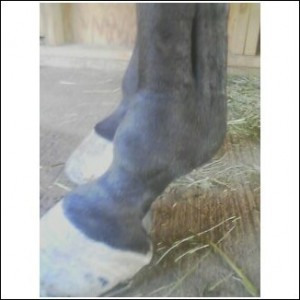Osteoarthritis
 Monday, July 8, 2013
Monday, July 8, 2013 
Osteoarthritis is one of the most common causes of chronic, low grade lameness in the horse, and one of the most common diseases treated by veterinarians. Osteoarthritis is generally seen as bony changes, and/or degeneration of the bone and cartilage of the joint surface (arthritis). As a result, there are many treatment and supportive care options currently marketed to horse owners. A few commonly asked questions are, “What is the difference between Legend and Adequan?” “Between Polyglycan and Pentosan?” “What is shock wave therapy?” This guide is intended to help answer some of those questions, however, a discussion with your veterinarian will help put together the best treatment or management plan for your horse.
Hyaluron, Hyaluronic Acid (HA), and Hyaluronate Sodium all refer to the same component of joint fluid in slightly different forms. Healthy joint (synovial) fluid is viscous, and Hyaluron is the substance that provides the cushion/viscosity to joint fluid. It is produced by the cartilage and cells within the joint fluid, and also helps decrease inflammation.
The effectiveness of an HA product is directly associated to is concentration and molecular weight. In general, products with higher concentrations of heavier weight molecules are more effective and have longer lasting results.
Legend:
Legend is Hyaluronate Sodium, a natural glycosaminoglycan (GAG) component of joint fluid. It can be administered intravenously (IV) or intra-articularly (in the joint). When given IV, treatment consists of a once a week injection for three weeks. When given IV, Legend decreases inflammation in the joint fluid, and helps decrease inflammation in the vessels surrounding the joint.
When injected in a joint to treat inflammation or synovitis, a full label treatment is a series of three joint injections spaced every 3 to 6 weeks. There is no period of rest needed post joint injection with an HA product. HA products injected into the joint act to lubricate the joint cartilage, and support lower quality joint fluid.
The concentration of Hyaluronate sodium in Legend is 10mg/mL.
Hyvisc:
Hyvisc is a Hyaluronate Sodium product labeled for intra articular injection for treating joint inflammation (synovitis) and osteoarthritis. It has a high concentration of a high molecular weight hyaluronate sodium (11mg/ml).
Polyglycan:
Marketed as a joint fluid replacement for use during orthopedic surgery, “Poly” is a combination product that contains Hyaluronic acid and Chondroitin Sulfates A and C. It can be given orally or intra-articularly. Its concentration of HA is 5mg/mL, (significantly less than that of Legend or Hyvisc) and it also contains10mg of sodium chondroitin sulfate and 10mg of N-acetyl-D-glucosamine per mL.
Its efficacy and longevity is considered less than other products, due to lower concentrations of HA, though it is also less expensive than Legend or Hyvisc, and some clients have reported positive results from Polyglycan administration.
Pentosan:
A beech wood derived polymer, Pentosan functions as an anti-clotting agent, as well as an anti-inflammatory. Pentosan can be used intravenously, intra-muscularly, intra-articularly, or orally. Pentosan stimulates new cartilage formation, as well as to block inflammatory mediators and to inhibit degredative enzymes. However research has shown that normal blood clotting time was effected 24hrs post administration, and up to 48hrs with large amounts given. Caution should be excersised in choosing to use Pentosan in horses with documented EIPH or within 48hrs of strenuous excersize.
Some university studies have shown similar effects at the cellular level to Adequan, clinical effects have not been proven.
Adequan:
Adequan is Polysulfated Glycosaminoglycan (PSGAG). It inhibits inflammatory enzymes in joint fluid, which decreases protein levels and increases HA levels. It is administered IM or IA. A full course of intra-muscular Adequan involves 7 treatments given once every 4 days for 28 days. It is often then continued once monthly if necessary. It has been shown to increase the level of HA in joint fluid for 4 days post administration.
Corticosteroids:
Intra-articular corticosteroid injections, in combination with non-steroidal anti inflammatories, are a common treatment for osteoarthritis. Corticosteroids have potent anti-inflammatory actions, however when injected in joints they are also destructive to the cartilage. Due to this corticosteroids are commonly combined with an HA product when injected into a joint, to help counteract the chondro-destructive effects.
Not all corticosteroids are as damaging to the joint surface. Triamcinalone acetonide (Vetalog) is slightly protective to the cartilage and has fewer negative effects on cartilage as other corticosteroids. Methylprednisolone acetate (Depo-Medrol) tends to have a longer period of action than Vetalog, but does degrade cartilage when injected into a joint.
Shock Wave Therapy:
ESWT refers to Extracorporeal Shock Wave Therapy. “Shock Wave” has been used for many years in sports medicine. It uses a hand held wand to deliver high intensity pressure waves to the horse’s body in pulses. Shock wave therapy has been shown to reduce inflammation within the joint, and stimulate new bone growth and soft tissue healing, as well as reducing pain.
Shock wave therapy is intended to be used in addition to a period of rest and healing. Since it provides pain reduction to potentially damaged areas, immediate work/training may cause increased damage. Two to four weeks of rest is required post treatment, depending on the condition being treated and its location.
Shock wave therapy can reduce osteoarthritis associated inflammation and clinical lameness, but it does not change the underlying problem, when utilized on sites of osteoarthritis (specifically joints). Thus chondroprotective treatments (HA product, Adequan, etc) are often added when shock wave therapy is utilized.


Reader Comments